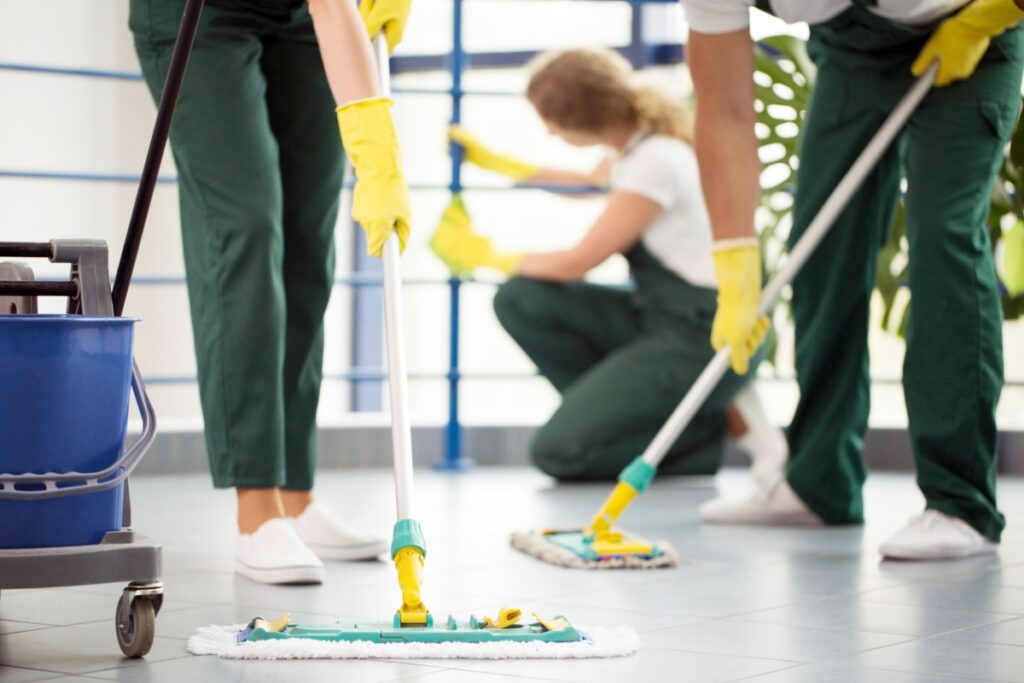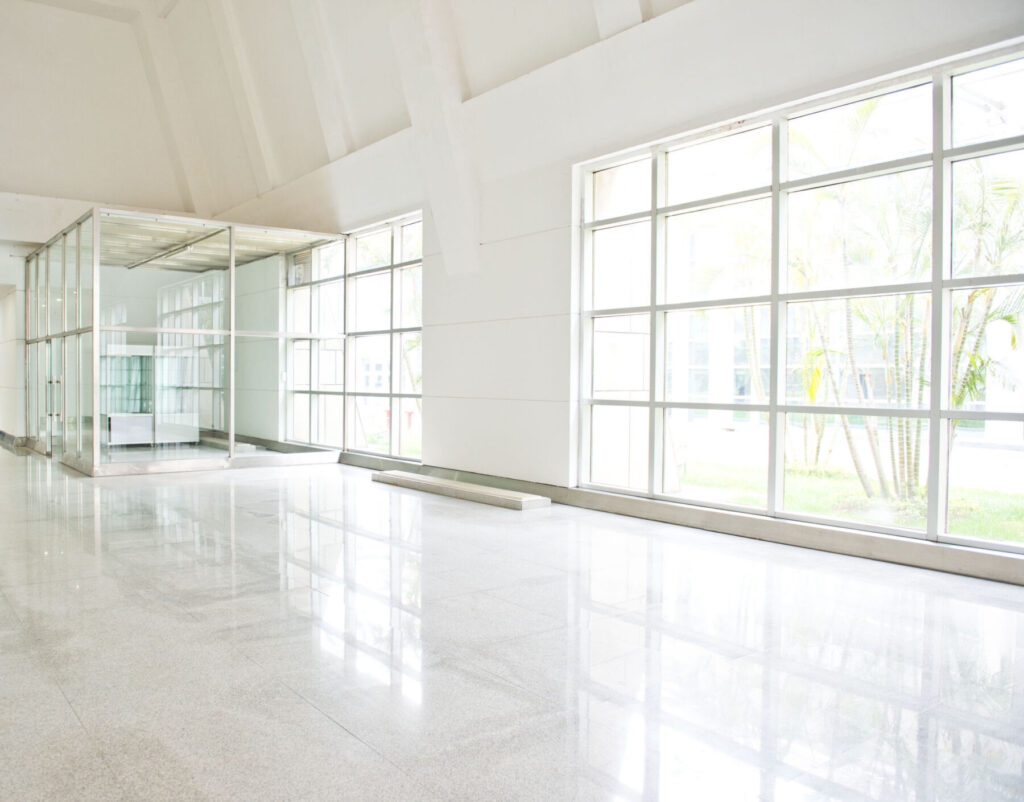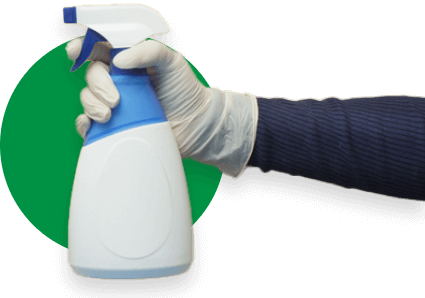Completing the commercial construction phase is about more than just handing over the keys. It’s about delivering a space that mirrors the quality and professionalism of the work done.
A crucial part of the transition from a construction zone to a pristine commercial environment ready for business involves post-construction cleaning, specifically focusing on how to clean floors, windows, and other surfaces effectively..
Our guide provides comprehensive information to achieve the highest standards of cleanliness, equipping you with the necessary knowledge and tips on how to clean floors after construction.
At Dallas Janitorial, we strive to ensure that every surface reflects a commitment to quality from the first day, providing a seamless transition to a welcoming and clean commercial space.
How to Clean Floors After Construction
Post-construction cleanup ensures a safe, clean, and welcoming environment.
1. Understand Your Floor Type
Before you start cleaning, identify the type of flooring material in your building. Each flooring has unique characteristics and cleaning requirements, from cement and lime concrete, widely appreciated for durability and cost-effectiveness, to more delicate materials like marble and glass, chosen for their aesthetic appeal in commercial spaces.
Notably, the hardwood flooring market is projected to grow almost 6% between 2024 and 2029, underscoring its enduring popularity in residential and commercial properties.
2. Gather the Necessary Supplies
Cleaning floors after construction requires a set of tools and materials to remove debris, dust, and stains effectively:
- Brooms or vacuum cleaners: Essential for removing large debris and dust.
- Scrub brush or microfiber cloths: For wiping and cleaning the floor surfaces.
- Bucket: To mix cleaning solutions and hold water.
- Mild detergent: Suitable for the specific type of flooring being cleaned.
- Clean water: Necessary for rinsing the floors after cleaning.
- Protective gear: Including gloves, safety goggles, or masks, depending on the cleaning agents used.
3. Follow Safety Guidelines
Safety is paramount when cleaning floors after construction:
- Wear protective gear: To protect against dust and chemicals, wear gloves, masks, and safety goggles as needed.
- Ventilate the area: Keep windows and doors open to ensure good airflow and reduce the inhalation of dust and chemical fumes.
- Be cautious with wet floors: To prevent slips and falls, clearly mark wet areas until completely dry.
- Follow cleaning product instructions: Use detergents and cleaning agents per the manufacturer’s guidelines to avoid damaging flooring materials and ensure personal safety.

Effective Commercial Floor Cleaning
The process of commercial floor cleaning following construction is meticulous and demands attention to detail. It’s not just about making the space look good; it’s about ensuring it’s safe and functional.
The Importance of Pre-Cleaning
After construction is complete, floors are often littered with various types of debris, including wood shavings, nails, screws, and dust. These materials can be hazardous to those entering the space and interfere with the effectiveness of later cleaning stages.
Removing this debris prevents potential injuries and ensures that subsequent cleaning efforts are more efficient and effective.
Next, Sweeping or Vacuuming
Once the larger debris is cleared, the next step is a systematic approach to sweeping or vacuuming.:
Depending on the type of floor, a broom or a vacuum cleaner will be more appropriate. For rough surfaces like unfinished concrete, a sturdy broom is ideal. For smoother surfaces or floors with fine dust, a vacuum cleaner with a filter suitable for fine particles is the better choice.
Follow these steps once you’re ready to sweep or vacuum your space:
- Begin cleaning from the top level of the space and work your way down. This method ensures that any dust or debris that falls during higher-level cleaning doesn’t contaminate already cleaned floors.
- Divide the space into manageable sections. This ensures that every part of the floor is addressed and helps maintain a focus on areas that might require more attention due to the accumulation of debris or stains.
- Sweep or vacuum in a consistent direction. This method helps gather all the debris in one direction, making it easier to collect and remove from the space.
- Pay special attention to corners and edges where dust and debris accumulate. A smaller hand broom or vacuum cleaner attachment is effective for these areas.
- Regularly dispose of the collected debris while cleaning. This prevents the re-distribution of dust and debris and keeps the workspace clear and safe.
- After completing a section, inspect it closely. Sometimes, a second pass is necessary to remove all debris and dust.
Ensuring Sparkling Windows in New Construction
The appearance of windows in a commercial space isn’t just a matter of aesthetic appeal, but also a reflection of the establishment’s attention to detail and maintenance standards.
In new construction, it’s vital to ensure windows are sparkling. Clean windows enhance the natural lighting and overall ambiance of your space and create a positive first impression on clients, employees, and visitors.
Post-construction windows often bear the brunt of residues such as paint splatters, dust, and fingerprints. Removing construction residues like paint splatters and dust is crucial. Techniques include using non-abrasive tools, appropriate cleaning solutions, and gently scraping for tough stains.
Achieving streak-free windows involves cleaning out of direct sunlight, using a squeegee for water removal, and drying edges with a microfiber cloth. Regular checks from various angles ensure all streaks are addressed.
This meticulous approach to cleaning floors and windows reflects a commitment to quality and safety, enhancing the space’s aesthetics and setting the standard for future maintenance.

Tackling Construction Dust on Walls
Removing construction dust from walls effectively involves a thorough approach to ensure a clean and healthy environment. Here’s a concise guide on how to clean construction dust from walls.
Dust Is Difficult to Detect
Construction dust, composed of fine particles from cement, silica, wood, and metal, can settle on various surfaces, including walls. Addressing this dust due to its potential health risks, such as respiratory issues and allergic reactions, is essential.
Particles Are Hard to Capture
A systematic cleaning approach is necessary to capture these fine dust particles effectively. Using tools to handle fine particulates, such as HEPA filter vacuums, ensures dust isn’t redistributed, but thoroughly removed.
Contaminants Can Be Hard to Reach
Given the propensity of construction dust to accumulate in hard-to-reach areas, including high corners and ceilings, use extendable dusters or long-handled brushes to clean hard-to-reach spaces.

Transform Your Commercial Floor Ambiance With Our Specialized Floor Cleaning Services
Our guide has highlighted key steps in cleaning floors after construction by emphasizing the need for a specialized approach to cleaning. Dallas Janitorial’s expertise in floor maintenance goes beyond just addressing post-construction cleanliness, we focus on creating a safe, appealing environment for all.
As reflected in our client reviews, choosing Dallas Janitorial means partnering with a team committed to excellence. Discover our tailored floor cleaning services, and let us help transform your space. For more details or to get started, contact us today.
Frequently asked questions about floor cleaning
How do I prepare for post-construction cleanup?
Prepare by starting with dry cleaning methods such as dusting and sweeping to remove loose debris. Follow a top-to-bottom cleaning approach to prevent dust from redistributing. Prioritize safety by using protective gear and following safety protocols.
What tools are best for cleaning construction dust from hardwood floors?
Use brooms with soft bristles and vacuum cleaners with attachments designed for wooden floors. To avoid damage, use mild cleaning solutions and a slightly damp mop.
What cleaning products should be used on floors after construction?
Opt for gentle, non-abrasive cleaners tailored to your flooring type. A pH-neutral wood floor cleaner is best for hardwood, while mild detergents or pH-neutral tile cleaners benefit tile floors. Avoid harsh chemicals and abrasive scrubbers.
How can I effectively remove construction dust from tiles?
Dust removal can be efficiently done using a professional-grade vacuum or manually with damp cloths, employing horizontal wiping motions. Ensure the cloth is rinsed frequently and the water is changed regularly to prevent the dust from spreading further.
What is the best cleaning solution for construction dust?
A highly effective cleaning solution is a mixture of two cups of white vinegar and a gallon of warm water. Apply the solution with a sponge mop and ensure the area is immediately dried with a towel to prevent residue or dullness.







